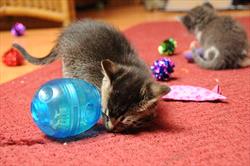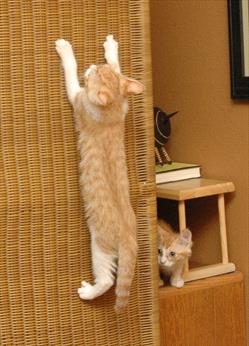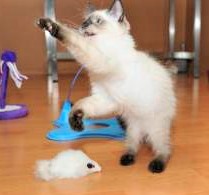Rachel photo 8-Canto.jpg

Photo Courtesy Canto Images
Cats are social animals and enjoy interactions with the humans in their lives. While some cats are particular, others will play with any object, toy, or person. Some cats prefer social play with their owners and some enjoy playing by themselves or with other animals in the home.
Cats come pre-wired with hunting skills. Most cats develop preferences for toys that copy normal hunting behaviors such as stalking, chasing, pouncing, grabbing, clawing, and biting. Typical kitten play behaviors often mimic these hunting skills.
Rachel photo 9-Canto.jpg

Photo Courtesy Canto Images
Play postures develop by three weeks of age and can involve social play with other cats and kittens. If cats do not have an outlet, these behaviors may be used inappropriately, resulting in stalking or attacking moving hands and feet. Introducing routines, finding new ways to play, and engaging your cat with healthy play activities encourage positive behavior.
Routines can minimize stress and create a predictable pattern for your cat to know how and when they can play. Play times should be at a time of day that works for your schedule. For example, if you are playing with your cat in the evening prior to bed, make sure playtime ends with a special treat that ends the hunting behavior and encourages rest. Toys such as wands, small mice, and fuzzy balls that encourage chasing and do not directly involve interactions with your hands are best. To keep things fresh, it is recommended to have a few toys out at a time and rotate them every two to three days, creating new excitement with each toy rotation. Food puzzles are another alternative to keep your cat engaged.
Outdoor exploration can be difficult to recreate inside. Supervised outdoor time in a catio or on leash and harness creates other positive ways to play, interact, and stimulate hunting behaviors. Some cats enjoy walks in an enclosed pet stroller or backpack carrier. You may need to condition your cat beforehand.
Understanding different ways to safely play and interact will encourage appropriate behaviors and strengthen the relationship between you and your cat.
Rachel photo 3-Canto.jpg
